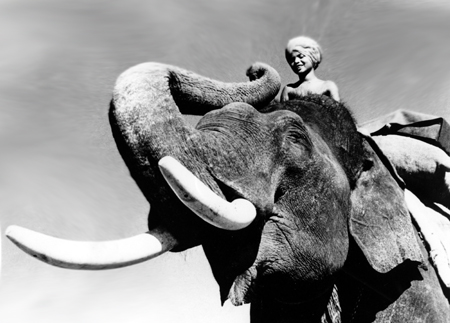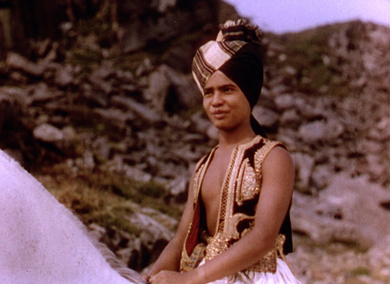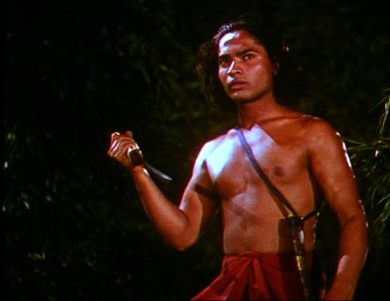
 |
|
|
|
Viewers enchanted by the Michael Powell/Emeric Pressburger 1940 The Thief of Bagdad will need little encouragement to sample more early film work by the remarkable actor Sabu. One of the most unique stars of the late 1930s was discovered under the name Selar Shaik, tending elephants in India. In Europe and America, where the idea of a real "jungle boy" stirred imaginations fired up by Edgar Rice Burroughs' Tarzan character. To audiences around the world Sabu was almost a fantasy figure, a tiny but limber Indian fellow who balanced a bright personality with fantasies of a natural existence in the almost-wilderness. Alexander Korda was already the biggest producer in England and perhaps Europe as well; the maker of prestige films practically was the British film industry for a number of years. To interpret the stories of writers Rudyard Kipling and A.E.W. Mason, Korda sent film crews to India and Africa, often with cameraman Osmond Borradaile, who took second position on Jungle Book and The Four Feathers despite filming dazzling Technicolor images under extremely hostile conditions. The location scenes for these films were seamlessly blended with scenes shot back in England, often months later. Eclipse's Series 30 disc set Sabu! rounds up the actor's remaining three Korda pictures, each of which is a special cinematic treat. 
Elephant Boy immediately captured hearts and imaginations and even won a Venice film festival best direction prize for its two directors, Zoltáan Korda and ethnographic filmmaker Robert Flaherty. The original story is a chapter from Rudyard Kipling's The Jungle Book, turned into an appealing colonial adventure with elements of both documentary and fantasy. Young Toomai (Sabu) tends his father's elephant, the towering Kala Nag, so well that they're practically a symbiotic pair, bathing together in the river and cooperating to steal melons ripening on the market rooftops. Englishman Petersen (Walter Hudd) is gathering a safari to capture more elephants for construction work. He immediately chooses the impressive Kala Nag, and when he sees Toomai's ease in handling the enormous monster, allows the boy to come on the dangerous trek as well. When the elephant herds prove elusive and tragedy strikes the caravan, jealous handlers declare Kala Nag to be a hazard. Fearing that his elephant companion will be shot, Toomai flees with him into the wilderness. He then stumbles upon a secret gathering place for hundreds of pachyderms, and witnesses their mysterious rituals. Elephant Boy enchants audiences from the moment Sabu scrambles atop his beloved friend's enormous head. Kala Nag picks his tiny handler up in his trunk and helps him ascend, and they stroll about with such confidence that the elephant can step over and around a baby without causing alarm (we're alarmed anyway). In footage usually credited to Robert Flaherty, the maker of the semi-documentaries Nanook of the North and Man of Aran, early scenes allow us to watch as Toomai takes Kala Nag to the river for a good wash. Not far away, a mother and calf bathe as well. The baby cavorts in the water so happily that it must have been an animation source inspiration for Walt Disney's Dumbo. We're told that Flaherty made his Korda connection years before, in attempt to sell the mogul on an essentially similar story about a Mexican boy and his bull. The colonial vision of Elephant Boy posits India as a happy place under English administration, and Petersen is a wise fellow. The Sahib exercises his prerogatives with admirable restraint, never losing his patience despite hardship and squabbles among the handlers. When Toomai absconds with Kala Nag, Petersen blames himself. The script smartly allows the naíve but ethical Toomai to follow his heart and earn an honored position among the handlers, even though he's still just a child. More political minds might see this as a pretty feeble reward, but Elephant Boy makes Toomai's promotion into a great honor. Adding to the film's charm is Sabu's natural speaking voice. The highly intelligent actor spoke no English but was not dubbed by another: he learned his lines phonetically, a dodge than only makes him sound more authentic. With his bright eyes and beaming smile, Sabu became England's next major star. A very young Wilfrid Hyde-White (of My Fair Lady) has a role as a colonial administrator. With the use of doubles and matching sets back in England, it's possible that few if any of the Anglo actors even went to India. The film's illusion of continuity is masterful. 
The Technicolor production The Drum (released in America as Drums) is a more traditional colonial military adventure from the author of The Four Feathers, A.E..W. Mason. Sabu has top billing in a story of a treacherous breakaway warlord set in the tribal desert of northern India, in what is now Pakistan. The story takes place in the 1920s, and the script by Lajos Biró is clearly meant to bolster English-Indian relations. Cast with star talent and climaxing in an exciting pitched battle, The Drum is also a guaranteed popcorn matinee performer. The cocky young Prince Azim (Sabu) greets an infantry column headed by Captain Carruthers (Roger Livesey) with a clever trick to see if the English can be easily fooled. Carruthers sees through Azim's charade and the two become fast friends, promising always to be truthful with each other. The British want to secure this corner of the Kingdom against armed incursions from the north, and unknown forces are importing machine guns and training rebels in their use., When his chieftain father is assassinated by his wicked uncle Prince Ghul (Raymond Massey), the honest young Azim finds himself the pawn in a cruel power play. The boy barely escapes alive and must pretend to be a beggar in the nearest city, where he appeals to Carruthers and his wife (Valerie Hobson) for aid. Carruthers has guessed Prince Ghul's strategy, but diplomatic necessity forces him to accept Ghul's invitation to take 50 troops to a dinner at the palace. Azim can't convince Carruthers' superiors of the threat, and risks his life to warn his new friend of the death trap that awaits him -- Prince Ghul has surrounded the pavilion with machine gunners. The Drum must have been a source of great national pride, as it presents the English Army as a beacon of stability and goodwill in India. Sabu even makes friends with a boastful young drummer-boy (Desmond Tester) who teaches him how to tap out a special recognition signal. Just as with Kipling's Gunga Din, Azim proves his loyalty by warning Carruthers, precipitating an unusually violent shoot-out between a hundred armed men in a confined space. The sinister Ghul (sounds like Ghoul) is not a religious fanatic, and makes a point of suppressing a fundamentalist calling for holy war. Having experienced real war with the Turks at Gallipoli, Ghul believes that he can only win against the colonial armies by creating a rebel alliance and leading the English enemy into a trap. Raymond Massey plays Prince Guhl as a scheming opportunist, hoarding cash for a quick getaway should his dastardly coup not pan out. Blessed with an amazingly sincere voice, actor Roger Livesey oozes British reserve and honor. Leaving for a reception that he knows to be an ambush, Carruthers tucks a pistol into his tuxedo and tells his wife that doing so is his proper function as a diplomat. Britain's greatest victories are often preceded by the sacrifice of good men to heathen treachery. Valerie Hobson lets her husband walk away with a look of quiet dignity: they both know that if he is killed, her life will be forfeit as well. The controlled emotions of their farewell capture the essence of the British "stiff upper lip". Just one year later, Sabu's acting is assured, as is his command of English. The actor's intelligence shines through his eyes; he's a genuine original. The only scenes that come off as forced in The Drum occur when Azim makes fast friends with his British counterpart, the cheerful drummer boy Bill Holder. Azim's eagerness to someday don a British uniform of his own seems a possible call for Indian recruitment. Although his films were sometimes controversial with Indian audiences, Sabu was enormously popular in the country of his birth. Leo Genn and Guy Rolfe are said to have uncredited parts in The Drum. Portly actor Francis L. Sullivan (Night and the City) has a plum role as the local Governor, who won't act on Prince Azim's pleas of calamity without corroboration from his own spies. 
For most of the video era Jungle Book has been seen only in inferior transfers, with the result that it is less well known than it deserves. With England and India engulfed in the war, Korda's production of The Thief of Bagdad was relocated to Hollywood in mid-filming, and Jungle Book followed suit. It lacks the authentic feel of the other pictures, yet is in keeping with the fantastic folk tales from the Rudyard Kipling source book. The jungle is a living thing that speaks to Kipling's young hero. The animals remain loyal to their separate species-tribes, yet speak with one another. They have names like Shere Khan, Kaa, and Baloo the bear. In an interesting touch, the story of Jungle Book is told by its villain, Buldeo the shopkeeper (Joseph Calleia). A generation ago the evil Tiger Shere Khan killed the husband of Messua (Rosemary DeCamp). Her baby disappeared the same day but did not perish; it was instead raised in the wild by wolves. Lean, scarred and unable to speak the human tongue, the feral Mowgli (Sabu) returns to his loving mother but is rejected by the superstitious, mean-spirited Buldeo. Mowgli soon learns to speak, and acquires a "tooth" (a knife) to slay his mortal enemy Shere Khan. Before he does he takes Buldeo's sweet daughter Mahala (Patricia O'Rourke) on a nighttime adventure to witness the magic of the jungle, and view the secrets of a forgotten ancient city. Mahala brings back a single gold coin from a fantastic treasure room. The coin inspires her father and his equally greedy friends the Barber and the Pundit (John Qualen & Frank Puglia) to torture Mowgli for the secret location. Mowgli calls on his friend Bagheera the panther to frighten Buldeo away, but the man only becomes convinced that Mowgli is a shape-shifting witch. When Buldeo threatens to burn Messua on a bonfire, Mowgli has no choice but to allow the bandits to raid the treasure. He knows that the evil riches within will cause the humans to destroy each other. Yet another masterful Korda production, Jungle Book creates miracles amid wartime shortages. The independent show (released by United Artists) has magnificent exterior sets enhanced and amplified by elaborate matte paintings and other optical effects. The entrance to the fabulous treasure room is through a cracked dome, a design lifted intact for the 1974 Harryhausen film The Golden Voyage of Sinbad. With the exception of some puppet snakes and a mechanical crocodile, the animals are all very alive and active. The filmmakers appear to have used partially hidden cameras, for in many scenes big cats prowl right up to the lens, filling the screen in with curious close-ups. This aspect of the film is very successful. Jungle Book has charm and humor to spare. No longer the tiny little Elephant Boy, Sabu now has a muscular, lean body that looks convincingly feral. His adjustment to the human village takes amusing turns. When Mowgli finds a bear rug on the floor of Buldeo's house, he remarks, "It's you ... you went missing several weeks ago!" The larger story takes a refreshingly unsentimental attitude toward nature. The great serpent Kaa says that he learned of Shere Khan's whereabouts from a now-deceased jackal, and points his nose to the lump in his body where the animal is being digested. Mowgli knows very well that the humans will betray one another when he leads them to the treasure, just as Buldeo allows his friends to kill each other in order to avoid direct responsibility for their deaths. The movie ends on the side of the jungle, when Mowgli proclaims that corrupt humankind should be shunned. Mowgli surprises us with his final choice. Binding the film together, Miklós Rózsa's masterful score expresses the wonder and majesty of nature. The music soars when Mowgli gives Mahala a grand tour of the wonders of his jungle home, bringing the matte paintings and the spray-painted palm leaves to life. Jungle Book is still a wondrous movie. Eclipse's Series 30 DVD of Sabu! is an optimized but not restored set of transfers of movies that are on the verge of slipping into obscurity, despite their former fame. All three look much better than the battered TV prints that circulated for decades on end. Elephant Boy is in the best shape, in crisp B&W with clear audio. The Drum is the weakest, especially at the beginning, which verges on the look of an older film-chain transfer. Both of the Technicolor releases have been mastered from composite negatives with occasional built-in registration flaws. Viewers asking why the films have not been fully rejuvenated, as has been done with titles like The Wizard of Oz need to understand that those laborious photochemical-digital restorations can cost millions of dollars. Few older films have the earning potential to make such efforts practical. Just the same, Jungle Book is a quantum improvement over an older laserdisc I once saw, where the Technicolor image was rendered in a high contrast that erased color values and plunged any un-lit object into inky blackness. Aside from some odd color values and an occasional mis-registered shot, Eclipse's transfer looks very good. Not having seen an original I.B. Tech print of Jungle Book I cannot say if the color and contrast values in the matte paintings are accurate. Some of them look fairly artificial. Eclipse discs normally have no special extras, but Michael Koresky's liner notes are once again informative and concise. We are told that The Drum played to a mixed reaction in India, where many in the independence movement considered it an insult.
On a scale of Excellent, Good, Fair, and Poor,
Sabu! Eclipse Series 30 Blu-ray rates:
Reviews on the Savant main site have additional credits information and are often updated and annotated with reader input and graphics. Also, don't forget the 2011 Savant Wish List. T'was Ever Thus.
Review Staff | About DVD Talk | Newsletter Subscribe | Join DVD Talk Forum |
| ||||||||||||||||||